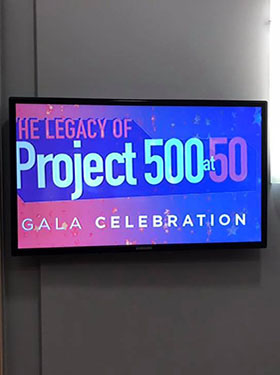During the final weekend of September, the University of Illinois celebrated the 50th anniversary of The Special Educational Opportunities Program, better known as Project 500. This initiative was the first comprehensive effort by the university to create a critical mass of traditionally underrepresented student populations on campus in the aftermath of the assassination of Dr. Martin Luther King Jr. in 1968. During that year, 565 newly admitted African American/Black and Latinx students matriculated to campus.
As a new doctoral student, it was an honor to attend the events to learn more about the program’s history and to meet alumni of the initiative. The anniversary weekend included a commemorative concert, panel discussions, and a gala. The overall tone of the weekend was a celebration of the brave students that stepped on campus in 1968 to create change and yet, to acknowledge that there still is significant work to be done to ensure equity in access and success for minority students at the university.
With the current educational debates about postsecondary access and equity for underrepresented students of color, it is essential to celebrate the efforts of initiatives like Project 500. A recent report released by the University of Southern California's Race and Equity Center, graded higher education institutions across all 50 states on black student success. The report evaluated each institution based on four equity indicators:
- Representation that black student enrollment reflects based on 18-24-year-old citizens of the state
- Gender proportionality among black students that indicates national gender enrollment distribution
- Degree completion based on the six-year graduation rate compared to overall institution graduation rate, and full-time
- Degree-seeking student to black faculty ratios. The State of Illinois received an overall equity index score of 2.20 based on a 4.0 scale
The Urbana-Champaign campus received an overall equity score of 2.25. Specifically, the university’s struggle with representation equity is highlighted with only 5.9% black student enrollment while the total traditional college age population of 18 to 24 year old Blacks comprise 17.6% of Illinois residents. This report echoes sentiments expressed during the Project 500 celebratory weekend that more work needs to be done in moving the needle on African American student enrollment.
The university is positioning itself to tackle this issue with the Illinois Commitment Scholarship Program beginning in the fall of 2019. This program will provide four years of tuition for entering freshmen that are Illinois residents with a family income less than $61,000. Given many underrepresented, underserved students of color are disproportionately from less affluent backgrounds than their White and Asian counterparts at the University of Illinois at Urbana-Champaign, it will be interesting to see how an initiative of this magnitude will increase access and peak interest of talented racialized minority students across the state. Also of note, will be how Illinois works to do move beyond attracting applications and enrollment to increasing persistence and completion for Black and Brown collegians.
